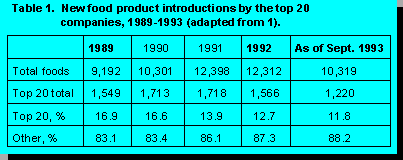 The title of this presentation was not my
choice, but that of the Program Committee. In this respect, I may not meet all the expectations
that are addressed in a title that covers a broad spectrum of important issues for the food
manufacturing sector. An analysis of the food processing sector investment in Research and
Development (R&D) and the success of the products developed shows that between 1984 and
1989, the annual number of new product introductions increased from 5,617 to 9,200 (2). From
this volume only one product in ten ever makes it as far as consumer-testing, and only 10% of
those ever make it to market. Therefore, it may be predicted that the market success of the
products developed is in the range of 1%.
The title of this presentation was not my
choice, but that of the Program Committee. In this respect, I may not meet all the expectations
that are addressed in a title that covers a broad spectrum of important issues for the food
manufacturing sector. An analysis of the food processing sector investment in Research and
Development (R&D) and the success of the products developed shows that between 1984 and
1989, the annual number of new product introductions increased from 5,617 to 9,200 (2). From
this volume only one product in ten ever makes it as far as consumer-testing, and only 10% of
those ever make it to market. Therefore, it may be predicted that the market success of the
products developed is in the range of 1%. In 1989, the top 20 new product companies were responsible for 16.9% of the 9,192 new food products introduced. As of September 1993, the leading 20 accounted for an 11.8% share of 10,319 new product introductions (5). Leading companies continue to produce the major share of new products developed.
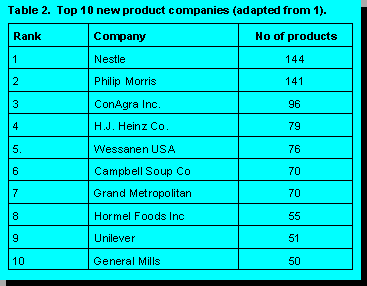 Fast and anticipatory responses to
consumer needs keep the leading new product companies on top. The top ten new
product companies are listed below in Table 2.
Fast and anticipatory responses to
consumer needs keep the leading new product companies on top. The top ten new
product companies are listed below in Table 2.
Friedman (4) estimated that it cost $54 million to introduce a new product into national distribution and for soft drinks the cost could run as high as $100 million. During this same time (1978-1988) the food industry generated the second highest return to investors among the Fortune 500 Companies (1) and food company stocks became hot properties.
On an industry-wide basis, about 60% of a food processors' R&D budget is devoted to product and process development. Therefore, I am confident that new product development will continue to provide the lifeblood of the food industry, including the dairy sector during the next decade. Research and development of new products and processes will have tremendous impact on the growth of the food industry. Many food processing industries know that only through increased spending on R&D will they find more efficient ways to exploit emerging technologies and marketplace opportunities.
What is "the Right Level of Investment" in R & D?
Cross-country comparisons and specific recommendations on the level of support for agricultural research is based on the agricultural research intensity (ARI) ratio. The ARI measures expenditures on agricultural research as a proportion of the value of agricultural product (AgGDP). The World Bank (9) recommends an investment target in agricultural research equivalent to two percent of agricultural gross domestic product. Ruttan (8) claims that there is a relatively high rate of return to agricultural research, often in excess of 35%.
The food sector contributes 16% to the U.S. gross national product and the food industry's
largest manufacturing sectors are the meat industry ($75 billion) and the dairy industry
($44 billion) (1). In Canada, the dairy industry is a major sector in our economy,
accounting for over 16% of consumer food and beverage purchases. It is considered an
$8 billion industry. If we accept the World Bank's two percent of AgGDP spending level
then the dairy industry should invest not less than $160 million (2% of $8 billion) per year
in research and 60% of that should be allocated for "direct" R&D. The Canadian
Agricultural Research Council in its review of dairy research and technology transfer in
Canada in 1992/93 estimated that approximately $147 million is spent annually on dairy
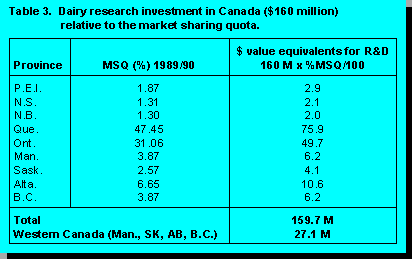 research which equates to 1.8% of
gross sales. It is my view that this figure is an exaggeration of the real R&D investment
because many categories of spending that are included do not follow the definition of
R&D. Let us consider the distribution of investment spending on dairy research in Canada
($160 million) in comparison to the market sharing quota entitlement by province.
research which equates to 1.8% of
gross sales. It is my view that this figure is an exaggeration of the real R&D investment
because many categories of spending that are included do not follow the definition of
R&D. Let us consider the distribution of investment spending on dairy research in Canada
($160 million) in comparison to the market sharing quota entitlement by province.
From the above analysis it may be concluded that investment in dairy research in western Canada should not be less than $27 M, 60% of which should be devoted to support "direct" R&D. The present stakeholder investment in research in western Canada is estimated at approximately $9 M. Clearly, there is not enough investment in R&D by the dairy sector in western Canada.
According to Prepared Foods magazine's 1990 annual R&D survey of 405 companies, independent food processors invest about 3.7% of sales in R&D, whereas subsidiaries of larger companies invest an average of 2.3% of sales in R&D. The majority of R&D investment (60%) is devoted to product and process development. The Globe and Mail recently (January 11, 1995) published results of a survey on R&D spending by Canadian companies. Most companies expect to increase their R&D investments by an average of nearly four percent a year between 1995 and 1999. The news is not all good though. Canadian companies still lag most of their key rivals in the industrialized world when it comes to R&D spending and the gap may be widening as other countries better prepare for the new economy. These statistics reflect the critical role that new product and process development plays to ensure both the short and long term health of the food processing industry.
Why Bother to Invest in Research and Technical Development ?
To address some of the above questions and to secure a profitable industry now and in the future, the dairy industry requires:
Sound investment in science based R&D will bring further technological and technical progress to the dairy industry. The majority of the distinguished audience here today at the Western Canada Dairy Seminar have done little or no research themselves, but have come here to learn and digest research results generated by the many dairy laboratories of the world including those from Alberta. Many researchers have spent a lifetime on basic and applied forms of dairy research. For the purpose of discussion, basic research has been defined as "experimental or theoretical work, undertaken primarily to acquire new knowledge of the underlying foundation of phenomena and observable facts without any particular application or use in view". Applied research is defined as "original investigation undertaken in order to acquire new knowledge but directed, primarily towards a specific aim or objective". In many cases there is no clear division between the types of research. However, I am assuming that we all are in agreement that research and technical development, be it pure, applied or experimental, is one of the most vital single forces serving the further development of our society. It is important to strike a healthy balance between all forms of dairy research.
The growth of R&D is significantly stimulated by the changing eating habits and needs of consumers and the emergence of the concept of milk as a multi-product generator for the food and non-food industry. Today's consumer demands an ever increasing range of fresh, fermented, low fat, dietetic, dessert and other types of dairy products, in addition to the traditional range of dairy products. Consumers expect such products to be nutritionally labelled and of a quality and price matching those of competitive products. The dairy industry across the world is responding to consumer demand by providing new products and different dairy ingredients which were generated by R&D of new technologies. More basic and applied research needs to be done to produce products with proper specifications regarding functional and nutritional properties.
A diet and nutrition-conscious public also needs to be convinced that milk and dairy products are safe. Here again, there are enormous opportunities for research of a fundamental and applied nature to underline still further the unique nutritional properties of milk constituents. The dairy industry cannot escape the ever increasing public awareness of environmental issues. There is need for increased R&D into the effects of environmental factors on milk and milk products, and on the effects of these products, especially waste products generated both on the farm and in the factory, on the environment.
In conclusion, the investment in R&D by the industry provides the following:
Key Concepts in Research & Development
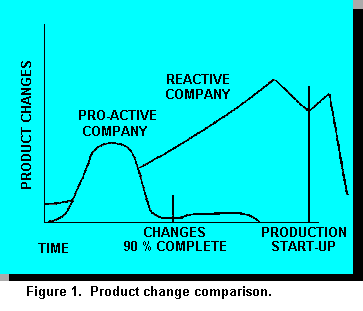 As an example we can look at two dairy
companies with two different approaches; one is proactive and the second is reactive. The
vertical
axis (Figure 1) represents the number of product changes during product development. The
proactive company has fewer overall changes than the reactive company in a significantly
shorter
time. For the proactive company, changes occur early in the process and are less expensive.
The
reactive company does not flush out preventable problems and will make an increasing
number of changes as time passes. The conclusion from the above example is that dairy
companies should move from a reactive to a proactive position to survive in the
competitive market.
As an example we can look at two dairy
companies with two different approaches; one is proactive and the second is reactive. The
vertical
axis (Figure 1) represents the number of product changes during product development. The
proactive company has fewer overall changes than the reactive company in a significantly
shorter
time. For the proactive company, changes occur early in the process and are less expensive.
The
reactive company does not flush out preventable problems and will make an increasing
number of changes as time passes. The conclusion from the above example is that dairy
companies should move from a reactive to a proactive position to survive in the
competitive market.
In a production oriented model, the dairy processing industry focuses on the manufacture of primary dairy products (cheese, butter, milk powder) and making profit from their sale. Major R&D will then center on the efficiency of converting raw material to final product, yield, technology, and processing. This approach ignores the fact that many products are sold because they fulfil certain functions for the consumer. As stated by Okkerse (6) the need is for the function of the product and not necessarily for the product itself. If the function can be better fulfilled by another product, then the consumer will switch to that product. A recent example of that trend in the dairy industry is the emergence of imitation dairy products.
Contrary to the production oriented model, the market oriented business strategy does not start from the product, but from the market. In this approach, the questions are: "What is the demand, what are the functions of the products, how may they be influenced by scientific findings, how will demographic, political, socio-economic, legislative and other factors influence the market ?". Market oriented business and R&D strategies will respond to changes in consumer preferences and ultimately profit from them.
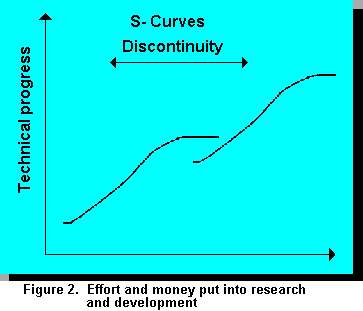 Another key concept in R&D is the
existence of S-curves. Initially, funds are put into developing a new product or process, progress
is very slow (Figure 2). In the next phase the progress is fast. Finally, as more effort or money
is
put into the development of a process or product, it becomes more and more difficult and
expensive to make technical progress. The specific technology approaches certain limits set by
the
fundamental laws of nature. This phenomenon is known as the concept of discontinuity of
S-curves in technology (Foster, 1986) and is illustrated in Figure 2. Further progress requires a
fundamental technological change from an entirely new and frequently different
knowledge base, a new S-curve needs to be created, resulting in a technological
discontinuity.
Another key concept in R&D is the
existence of S-curves. Initially, funds are put into developing a new product or process, progress
is very slow (Figure 2). In the next phase the progress is fast. Finally, as more effort or money
is
put into the development of a process or product, it becomes more and more difficult and
expensive to make technical progress. The specific technology approaches certain limits set by
the
fundamental laws of nature. This phenomenon is known as the concept of discontinuity of
S-curves in technology (Foster, 1986) and is illustrated in Figure 2. Further progress requires a
fundamental technological change from an entirely new and frequently different
knowledge base, a new S-curve needs to be created, resulting in a technological
discontinuity.
ln all these examples the function of the product remains more or less the same, but it might be better fulfilled by new products or materials. ln the food area we may think of the switch in Western societies from high fat to low fat products on the basis of nutritional findings. High pressure processing technology, biotechnology, membrane filtration technology, and environmental policies are a few examples of technological tools or barriers that will have an impact on new product development.
Forces Shaping Investment in Industrial Research
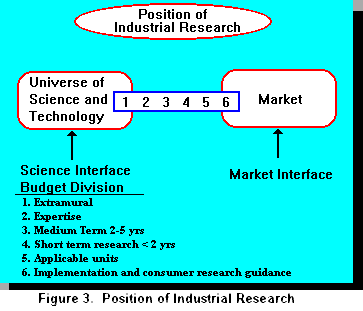 The major components affecting the
industrial R&D process and their interrelation is shown in Figure 3. First of all there is the
universe of science and technology as accumulated over time and published in scientific
journals,
patents, and conference proceedings. This public know-how is expanding (changing)
continuously and it is of paramount importance for an industrial research organization to keep
track of all work relevant to that industry which is going on in universities and other research
institutions, and to maintain strong links with these institutions. This is called the science
interface.
The major components affecting the
industrial R&D process and their interrelation is shown in Figure 3. First of all there is the
universe of science and technology as accumulated over time and published in scientific
journals,
patents, and conference proceedings. This public know-how is expanding (changing)
continuously and it is of paramount importance for an industrial research organization to keep
track of all work relevant to that industry which is going on in universities and other research
institutions, and to maintain strong links with these institutions. This is called the science
interface.On the other end of the scale there is the market, worldwide and continuously changing, depending on all the factors mentioned before, and also on the creation of new S-curves by scientific discoveries. This market orientation is specific for industrial research and distinguishes it from, for example, research at universities. It requires an intimate knowledge of that market, of consumer habits, etc. This is referred to as the market interface. lndustrial research taps the universe of science and technology, gives additional value and knowledge to it for the benefit of that industry, and focuses this science and technology on the needs and opportunities of that market. In order to carry out this task properly a whole range of disciplines are required in order to be able to communicate effectively on the one hand with the universe of science and technology, and on the other hand with the market. Going from left to right in Figure 3, the profile of science and scientist changes from longer term to shorter term, from research to development.
Final Remarks
References